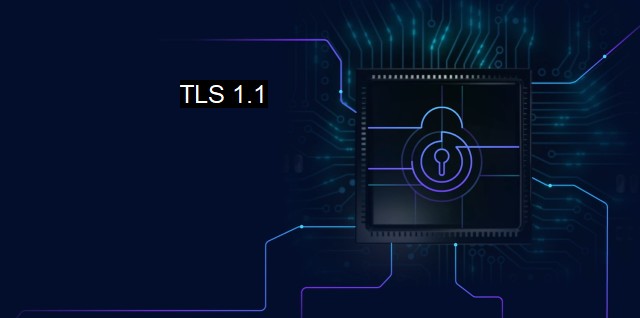What is TLS 1.1?
Understanding Transport Layer Security 1.1: The Importance of TLS in Cybersecurity
TLS 1.1, short for Transport Layer Security version 1.1, is a cryptographic protocol used to secure internet communications between a web server and a client. By using this protocol, both parties can verify each other's identity and exchange data safely, which is a critical service amidst the burgeoning growth of cyber threats.Internet services, like online banking, email communication, and e-commerce, need secure avenues for transporting sensitive and personal data. Organizations aim to safeguard their valuable data and reputation by implementing security networks. This emphasis on security has engendered several security protocols; TLS 1.1 is one such advance, with its predecessor being TLS 1.0.
TLS 1.1 heralded several improvements over its predecessor. For once, protection against Cipher Block Chaining (CBC) attacks was enhanced through the encryption of all content, not just user data—a feature created in response to vulnerabilities found in 1.0. Its explicit Initialization Vector (IV) prevented an attacker from predicting pattern changes, and thus actions couldn't be preemptively blocked to serve malicious intent. TLS 1.1 went strides for cybersecurity at the time, allowing trust in cyber networks to be maintained.
Another key feature of TLS 1.1 lies within its backward compatibility. This means that it is capable of "downgrading" its service so that older, less advanced systems can also communicate securely—a trait boding considerably well for antiviruses that may come to rely upon its security measures. by improving upon 1.0, TLS 1.1 lessened prevalent risks and mounted better defense in the face of cyber threats.
In terms of its contribution in battling malware, the protocol provides secure platforms where antiviral software databases can remain updated and constantly communicate with their hosting security companies. Security providers can utilise this secure channel, allowing applications to download patches, updates, and synchronize data in real time. With the continuous risk of cyber threats, the part played by updated antivirus software in situations where communication is moved through non-secure channels is indispensable, and TLS 1.1 fostered that secure environment to run these updates.
Simultaneously, TLS 1.1's secure connections protect saved cards and online banking details against malicious software attempting to steal such information. Cyber criminals, in their quest to infiltrate a victim's bank account or commit identity theft, often use this data they can gather from surveying poor encrypted connections. Secure connection provided by TLS 1.1 based websites considerably reduces this risk.
Nonetheless, like anything to do with technology, remaining static is historically akin to moving backwards, and protocols such as TLS 1.1 are no different. As time and technology progress, newer, more reinforced protocols were developed; metonymously, hacker techniques have also been advancing and older security measures may not be enough. Specifically, the current recommended protocol version is the newer TLS 1.2 or the latest TLS 1.3. Many modern websites and applications don't even support TLS 1.1 anymore, due to its now outdated modes of security.
But despite its discontinuance and fading use in the face of progress, the advances fostered by TLS 1.1 have held substantial impact on the world of cybersecurity. It has been an influential player in the formation of modern security protocol standards, refining prevalence risks and enhancing overall protections against attacks. It helped create safer avenues for antivirus software to update and communicate on, bringing about high volumes of security services. Therefore, amidst a dynamic and hazardous cyber environment, TLS 1.1 has rightfully claimed its place in the annals of cybersecurity.

TLS 1.1 FAQs
What is TLS 1.1 and why is it important in cybersecurity?
TLS 1.1 (Transport Layer Security) is a cryptographic protocol used to secure communication over a network. It is important in cybersecurity as it provides a secure channel for sensitive data to be transmitted, such as personal and financial information.Is TLS 1.1 still considered secure in today's cybersecurity landscape?
TLS 1.1 is no longer considered secure in today's cybersecurity landscape due to vulnerabilities that have been discovered in its encryption algorithm. It is recommended that organizations upgrade to the more secure TLS 1.2 or higher.How does antivirus software interact with TLS 1.1?
Antivirus software can inspect the traffic that is transmitted over TLS 1.1 to detect and block any malicious activity. Some antivirus software can also decrypt and re-encrypt the traffic to perform more thorough scans.Can TLS 1.1 be disabled to improve cybersecurity?
Yes, disabling TLS 1.1 can improve cybersecurity as it eliminates the risk of vulnerabilities associated with the protocol. However, it is important to ensure that all systems and applications are compatible with newer protocols before disabling TLS 1.1.| | A | | | B | | | C | | | D | | | E | | | F | | | G | | | H | | | I | | | J | | | K | | | L | | | M | |
| | N | | | O | | | P | | | Q | | | R | | | S | | | T | | | U | | | V | | | W | | | X | | | Y | | | Z | |
| | 1 | | | 2 | | | 3 | | | 4 | | | 7 | | | 8 | | |||||||